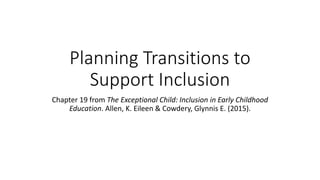
Planning transitions to support inclusion
- 1. Planning Transitions to Support Inclusion Chapter 19 from The Exceptional Child: Inclusion in Early Childhood Education. Allen, K. Eileen & Cowdery, Glynnis E. (2015).
- 2. Early Childhood Transitions • Children may transition from one program to another for a variety of reasons. • A child’s age • A diagnosis • A family move • The primary purposes of transition services • Identify accommodations that may be necessary when moving from one program to another • Help ease stress and unhappiness • Prevent interruption in services for children with identified disabilitites • Avoid duplication of services
- 3. Transition Process • Develop planning team • Parents • Someone from receiving program • Someone from current program • Set goals for child • Know and understand curriculum and expectations of new program • Identify differences between current and new programs • Know child’s current levels • Identify potential challenges and solutions
- 4. Team Members and Their Roles • Role of current program • Provide support for child and family • Provide up to date information and evaluations to the new program • Identify skills the child may need for the new program and work on helping the child attain those skills • Role of new program • Meet with child and family prior to enrollment in the program • Identify potential problems the child may encounter in the new program • Disseminate any information that is needed by anyone who will work with the child in the new program • Discuss and understand parent concerns and wishes as it relates to their child
- 5. Parents’ Roles • Be an advocate for their child • Transition from family-centered to child-centered program • Gather and share information as they feel comfortable (professionals must be aware and accepting of varying amounts of family participation as team members) • Remember the 3rd core consideration of DAP? “Knowing what is culturally important” (NAEYC 2009) • Remember NAEYC Ecada Standard 2?
- 6. Professionals Must. . . • Remember the 3rd core consideration of DAP? • “Knowing what is culturally important” (NAEYC 2009) • Remember NAEYC Ecada Standard 2? • STANDARD 2. BUILDING FAMILY AND COMMUNITY RELATIONSHIPS Candidates prepared in early childhood degree programs understand that successful early childhood education depends upon partnerships with children’s families and communities. They know about, understand, and value the importance and complex characteristics of children’s families and communities. They use this understanding to create respectful, reciprocal relationships that support and empower families, and to involve all families in their children’s development and learning. Key elements of Standard 2 2a: Knowing about and understanding diverse family and community characteristics 2b: Supporting and engaging families and communities through respectful, reciprocal relationships 2c: Involving families and communities in young children’s development and learning (NAEYC 2011) • Work to identify any barriers to meaningful family participation.
- 7. Writing the Transition Plan • The goals have been identified • What is needed for the transition itself? • What specific activities and strategies are planned? • Who is responsible for carrying out the various components of the plan? • What is the timeline for carrying out the parts of the plan? • How successful was the transition? • How has the child adapted to the new program?
- 8. Specific Transitions • From Early Intervention Services to Preschool • At 3 years, a child becomes eligible for public school services • Service delivery generally changes from home-based to a center-based setting. • IFSP (individualized family service plan) is replaced by an IEP (individualized education plan) • IDEA requires transition planning for all 3 year olds identified with disabilities beginning at least 90 days prior to the child’s 3rd birthday. • Children with exceptionalities cannot be required to have prerequisite skills prior to being enrolled in preschool (ADA) • Services must be provided without interruption, if a child’s IEP indicates a need for continued services, even if the child’s birthday occurs in the summer. • The law requires that children receive services in the least restrictive environment (LRE)
- 9. Transition to Kindergarten • Planning is recommended, but not required by legislation • Recommended steps • Plan in the spring • Visit potential programs for “goodness of fit” • Assess the environment • Assess the interactions • Assess activities and curricula • Assess management strategies • Prepare the child • Allow child to meet teacher • Prepare child with any skills needed • Child goes to kindergarten • Provide informal support services • Evaluate child’s adjustment to the new setting
- 10. References • Allen, K. E., & Cowdery, G. E. (2015). The Exceptional Child: Inclusion in Early Childhood Education. (8th Edition). Cengage Learning. Stamford, CT. • Developmentally Appropriate Practice (DAP) | National Association for the Education of Young Children | NAEYC. (n.d.). Retrieved from http://www.naeyc.org/DAP • National Association for the Education of Young Children. (2011). 2010 Standards for Initial Early Childhood Professional Preparation. Retrieved from http://www.naeyc.org/ncate/files/ncate/Initial_2pager.pdf